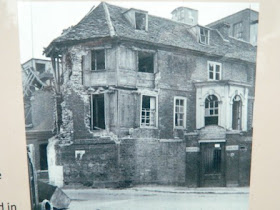 |
Hogarth's House - the red-brick building behind the garden wall.
Note the narrow country lane running outside the perimeter.
I don't remember how my fascination with the Georgian artist, William Hogarth began - but last weekend it led me to visit his house in Chiswick. This turned out to be a bitter - sweet experience. On the plus side, the house has been beautifully restored and is FREE to enter - on the minus side, the area around the house has become perhaps one of the most dirty, depressing areas of London, complete with an arterial dual-carriageway right outside the garden wall.
|
 |
Here I am (March 2013) with my back against the same wall
shown in the painting above.
Sad - isn't it?
Hogarth was very much a creature of London and used his observation of the city characters to fuel his art. However, in the early 18th century the capital was a very unpleasant place in the summer heat and to escape the stink and risk of disease, Hogarth bought a house in rural Chiswick (see the print below the next photograph to see how the area looked in his day.)
|
 |
The house as it is today
(As close as I could get to the top picture - without getting run over!)
|
 |
The house as Hogarth would have seen it in the early 18th century
looking across Chiswick Common Field
The house was built between 1713 and 1715 in what was then a walled orchard. The Hogarth family used it from 1749.
|
 |
Images of the house circa the 19th century
In Victorian times the house was lived in by the Clacks and the Coles. The Coles were market gardeners, whilst it was recorded that Mrs Clack kept pigs in the garden and ran a shop in her living room. In 1890 a gentleman called Alfred Dawson restored the house and let it to a nurseryman, John Allgrove.
|
 |
This mulberry tree is centuries old -
Growing in the garden of Hogarth's House
(Annexe in the background)
This plot of land was enclosed in 1670 to form a walled garden and it was planted with a variety of fruit trees. It seems likely that the Downes family planted the mulberry tree (above) in the late 17th century - and it is still thriving to this day. The photo below shows Mr Allgrove and his wife Elizabeth, in the 1890's, standing beside the mulberry tree in front of the house.
|
 |
Standing in front of the mulberry tree are the Victorian inhabitants of the house;
Mr Allgrove, his wife Elizabeth, and another lady. |
 |
The house was damaged in WWII by a parachute bomb.
The house was badly damaged in 1940 by a parachute mine and remained semi-derelict and boarded up until the 1950's, when Middlesex County Council repaired the house and opened it to the public. After a more recent refurbishment, it was opened again as a museum in November 2011 (by the comedian Dara O'Briain - I have no idea what connection he has to Hogarth but I'd love to know!)
|
 |
A travesty!
If you're going to name a building after Hogarth-
make sure its worthy of his name. |
And finally, if you are going to use someone's name - at least do them the decency of making the building worthy of it!










Thanks for this interesting entry. As you say, bittersweet, but I always enjoy comparing the 'then' and 'now' pictures of a famous place.
ReplyDeleteI think what amplified the contrast was that the house itself was so lovely - I may post pictures of the interior next week. However, standing inside looking out, all the magic was destroyed by vistas of grim, grey concrete and horrible noisy traffic.
DeleteThank you for leaving a comment,
G x
Thanks for this I have been meaning to visit since reading Jenny Uglow's 'Hogarth'so good to experience this vicariously through you.
ReplyDeleteJulia
Hi Julia,
DeleteI'm reading Jenny Uglow's book at the moment - such a good read and a great insight into cultural attitudes of the day. My only regret is that I have the book on Kindle and the illustrations come up quite small - half wishing I'd gone for the physical version so I could see the pictures better. On the up side, I hate writing notes in books and at least on the Kindle it's easy to highlight interesting parts without appearing to deface the pages.
Thank you for leaving a comment,
Grace x
I love reading about "then" and "now". Hogarth House was so beautiful in its earlier surroundings. The house still is beautiful, but it's such a different environment. No wonder people like to step back into historical novels where the settings were so much more inviting.
ReplyDeleteThanks for this share.